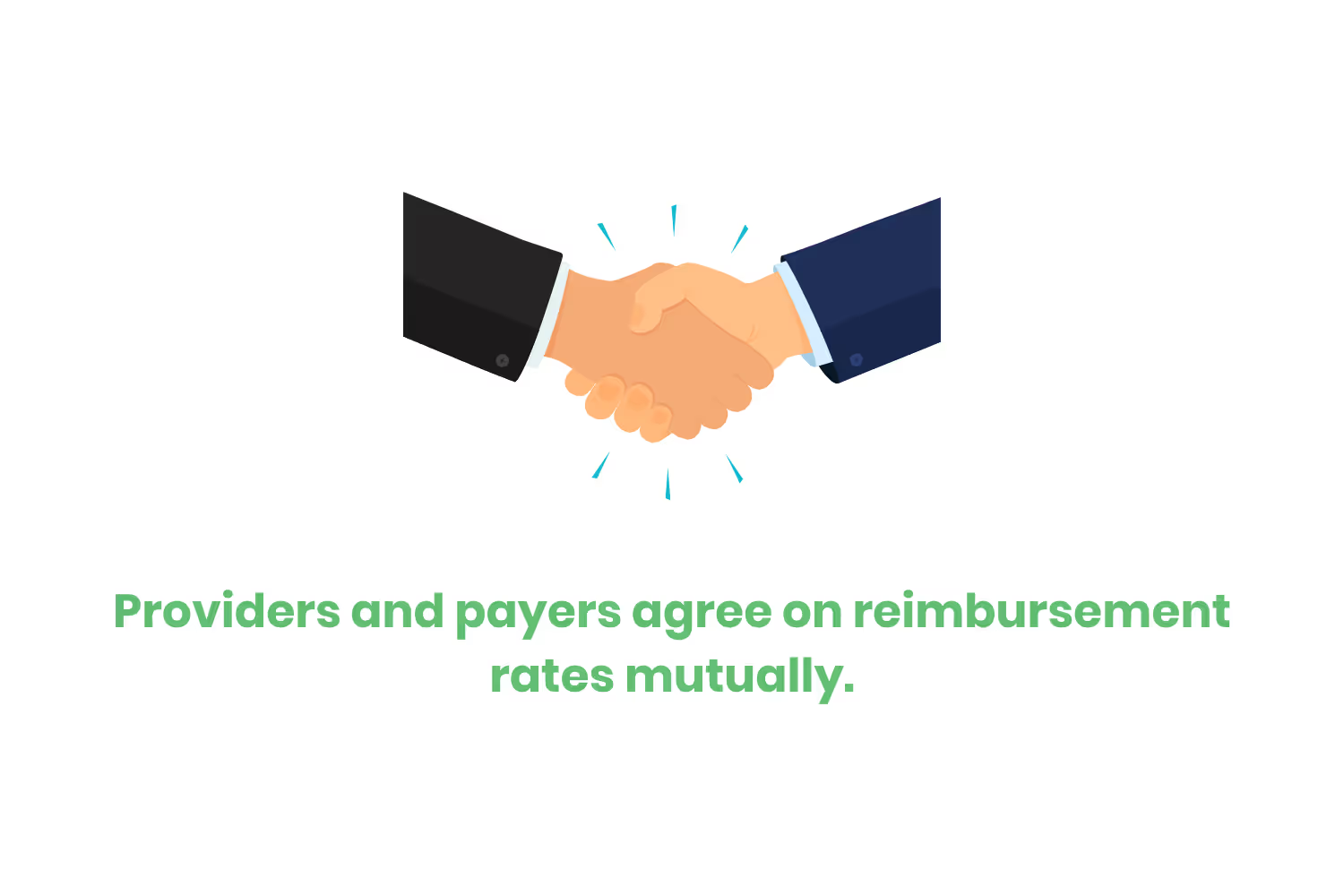[ANSWERED] What is a Payer Agreement?
In this blog we dissect what a payer agreement is!

On average, a healthcare provider has between 16 and 20 payer contracts. This is according to a survey conducted by Defacto Health in April of 2023.
You may be wondering, is this too much? Or too little? There’s no right answer, but understanding what a payer agreement is will show the significance of that average number.
These payer contracts, also known as payer agreements, ensure that healthcare providers receive proper reimbursement for the care they provide to patients that get covered by a payer.

A payer commonly looks like insurance companies, government programs, and employers. There all different types of payers.
Now, I’m no lawyer, hearsay, but this blog is about what a payer agreement is.
Whether you spell it p-a-y-o-r or p-a-y-e-r, it’s referring to the same thing. (It’s common to see both forms of spelling.)
Let’s discuss what it is.
Payer Agreement: Defined
A payer agreement is a contractual agreement between 2 parties. This means that there’s a legal obligation for both parties to follow it.
It’s between a healthcare provider and a specific patient’s payer. Not every patient’s payer is the same. This is why providers have contracts with each payer. One does not apply to all.
For example, the payer agreement between a healthcare provider and an insurance company such as Blue Cross and Blue Shield is going to be different from the payer agreement between a healthcare provider and a government-funded agency such as Medicare or Medicaid.
These agreements set clear expectations and guidelines for the healthcare provider’s reimbursement from a payer.
These contracts can cover a lot of information. It’s quite specific for good reason.
Payer agreements help foster mutually beneficial relationships between providers and payers. There is a purpose in the partnership for the provider, the payer, and the patient.
We will cover some benefits in depth in just a bit, but here are a few.
Payer agreements set standards that are compliant and mitigate financial risks. They ensure both fair and timely reimbursement for services received which is quite important.
According to a Quora thread, the average time it takes for a provider to get paid is around 30 days. Of course, there are a lot of different factors that come into play, but we can look at this average and say about a month.
Any time over a month would not be ideal. Payer agreements aid in making sure providers get paid as soon as possible.
Payer agreements also help make sure the quality of care given to patients is at the highest level it can be. Setting standards for the type and quality of care that patients receive promotes not only the well-being of the patients, but the structure and how a healthcare provider operates as well.

A payer agreement is a sort of checks and balances. As we’ve said it can cover a lot of different topics or areas of the transaction.
Some of the topics outlined in a payer agreement are reimbursement rates, coverage, claims submission, billing procedures, payment terms, compliance requirements, and a termination clause.
Did you got all that? Good.
Just kidding! The next section of this blog will be your payer agreement glossary. We’ll go over what each of these topics unveils within their section of the contract.
Included Topics
Providers and payers agree on reimbursement rates mutually. It’s a certain monetary amount that a payer will pay a provider for a specific medical service or procedure that a patient has received.
For these reimbursement rates finalized, they must exist within the payment agreement. This brings us to coverage.
Coverage includes any specific services, treatments, or procedures that get listed under the payer's plan.
For a payer to be aware that a provider needs reimbursement and it falls within the payer agreement to do so, there must be procedures in place for submitting claims.
The claims submission process within a payer agreement provides requirements for necessary documentation and coding that must be present.
Once claim submission occurs, it’s time for billing. The billing procedures serve as guidelines for billing practices. These guidelines include timely filing of claims as well as requirements of how to bill information accurately.

Once all of the topics so far have get completed, it’s time for payment.
Payment terms explain how and when the healthcare provider will receive their reimbursement for services completed.
We’ve talked a little bit about how payer agreements help keep related parties in compliance. Compliance requirements such as coding standards and documentation practices are regulatory expectations regarding compliance that must be upheld.
Last but not least is the termination clause. The termination clause lists the conditions under which either party may terminate the agreement. It also includes any associated notice requirements.
Now that we are familiar with topics included within a payer agreement, let’s go over more benefits.
Benefits of a Payer Agreement
Payer agreements are important for several reasons. There are benefits associated with them. As we’ve gone over, they create mutually beneficial relationships for both providers and payers.
For payers, they provide timely and accurate reimbursement. For patients, patient agreements ensure that they are getting the utmost quality of care. There’s a certain standard that needs met.
Another benefit of payer agreements is clarity. All the information available exists within the contract. The established terms and conditions explain how and when a provider receives reimbursement as well as for what services receive coverage by the payer.
In payer agreements, another mutual benefit is cost. Negotiated reimbursement rates give providers an estimated revenue of what they will receive for providing specific services or offerings. Having an accurate estimate helps providers manage costs accurately. If a provider didn’t have reimbursement rates from a payer agreement, they wouldn’t know their reimbursement rates. Not knowing what you are going to receive reimbursement for can lead to issues with planning and budgeting. It also doesn’t give you an accurate estimate of pricing for your services.

As we’ve mentioned previously, payer agreements aid in satisfying compliance requirements. Compliance is important. Failing to comply can lead to fines, a bad reputation, potentially jail time, and even more. I won’t go on with the doom and gloom, but I think you get the point.
Making sure your operations, policies, and procedures are following government-mandated guidelines is a must. Within payer agreements, there are requirements for compliance in regard to regulatory standards, coding practices, and documentation requirements.
An example of regulatory compliance would be adhering to HIPAA laws.
HIPAA is short for the Health Insurance Portability. It’s a federal law that protects sensitive patient information within the healthcare industry.
HIPAA’s requirements prevent the sharing or disclosing of protected health information, or PHI, without a patient’s consent.
We have a lot of content related to HIPAA as well as its policies and procedures.
Coding compliance makes sure that the coding of services and data follows all coding standards. It is set in place to make sure that providers are documenting information accurately which leads to reduced claim denials and audits.
Insurance companies deny between 10% and 20% of healthcare claims each year.
A denial happens when an insurance company or other carrier denies a request for coverage on healthcare offerings or services for a patient from a professional.
Documentation compliance is similar in that it sets forth standards of how to accurately document patient information and all data to avoid any legal issues related to both billing and reimbursement.
I might sound like a broken record bringing this up again. Payer agreements upkeep positive, beneficial relationships between payers and providers. How so? Expectations from both parties as well as their rights and responsibilities exist within these agreements. There is a mutual, understood expectation for the payers and providers to follow.

We mentioned a termination clause in the areas covered within a payer agreement. If either party would like to terminate the payer agreement due to whatever reason, that option is there as well.
A provider network is a list of healthcare providers covered within an agreement plan. This gives patients selections to choose from when seeking out medical services. Provider or payer networks are often included within a payer agreement. This gives patients options for healthcare services, offerings, and doctors while also ensuring their coverage for services.
The average amount of payer agreements or contracts a healthcare provider has is between 16 and 20. Having multiple negotiated payer contracts with favorable terms helps providers to bring in more than one stream of revenue. Don’t put all your eggs in one basket is a saying that applies here.
Having multiple streams of revenue helps mitigate financial risks that could potentially arise with changes in reimbursement rates or patient demographics.
Payer agreements are beneficial for multiple reasons. They create mutually beneficial relationships, ensure compliance, and avoidance of fines or denials. Payer agreements also help ensure quality care to patients as well as timely reimbursement for the provider.
Payer contracts diversify revenue streams while also shedding more insight into reimbursement sent to providers.
The Process of Receiving a Payer Agreement
You may be wondering now how a payer agreement comes to be. Let’s go over a general overview of the process as well as the typical lifespan of a payer agreement in case you’re looking to create one.
First, a healthcare provider must express interest with a specific payer about becoming a participating provider. Most of the time, it’s for whatever reason listed in the benefits above. A provider may be looking to increase revenue, expand the number of payers they work with, or want to create more options for their patients’ access to care.
The second step is negotiating. As I’ve said before, this is a mutually beneficial relationship. Both the providers and payers will share what they are looking for and then create an outline of the terms and conditions for their contract. It’s sort of like a give-and-take. A lot of discussion is going on to figure out reimbursement rates, coverage, claims submission, billing procedures, payment terms, compliance requirements, and a termination clause. All the things we covered in the topics area of this blog! A rough draft of sorts gets created.
Once the rough draft exists after the negotiation phase, it’s time for the parties to review the terms. Changes may occur to the terms depending on each party's wants and needs. It may take multiple drafts for the parties to mutually agree on the contract as a whole.

When the parties mutually agree on a contract, it’s time for legal counsel to review the agreement. This legal counsel is not biased toward either party but is working with both to make sure that it is in compliance and clearly states what the payer and the provider are negotiating.
After the legal counsel approves, authorized representatives of the healthcare provider and payer sign the contract. An agreement is born and implemented. The provider begins to offer services within their payer agreement and then submits their claims to the payer.
As both parties work within their contract, both are making efforts to upkeep compliance and make sure to communicate present issues. They typically have a renewal date to negotiate or terminate the terms depending on their mutual agreement.
There’s no certain amount of time that each of these steps should take. It all depends on the provider, their size, the payer, and the complexity of the agreement.
It’s common for payers to have premade templates that are useful during that negotiation process while others are open to a more customized, thought-out plan to meet specific provider needs.
Conclusion
If you’ve made it this far I think it’s safe to say that you’re a payer agreement pro!
Payer agreements are a specific, mutual contract between a healthcare provider and a payer. It’s a set of negotiated terms and conditions for how much a payer will reimburse a provider for the covered patient’s services.
A provider oftentimes has multiple payer agreements because they are specific and cater to the relationship between each payer.
Payer agreements or contracts offer many benefits to providers, payers, and patients alike.
They cover many topics within the claims submission and billing process. For good reason! The more specific, the better.
The clarity within the contract sets clear expectations and standards for how both parties should operate.
There is a process and steps to take to enter into a payment agreement, but due to the complexity and specific terms and conditions associated with different payers and providers, there’s not one way that it should look.
I hope this gave you an idea of all you need to know about payer agreements.
Emphasize your product's unique features or benefits to differentiate it from competitors
In nec dictum adipiscing pharetra enim etiam scelerisque dolor purus ipsum egestas cursus vulputate arcu egestas ut eu sed mollis consectetur mattis pharetra curabitur et maecenas in mattis fames consectetur ipsum quis risus mauris aliquam ornare nisl purus at ipsum nulla accumsan consectetur vestibulum suspendisse aliquam condimentum scelerisque lacinia pellentesque vestibulum condimentum turpis ligula pharetra dictum sapien facilisis sapien at sagittis et cursus congue.
- Pharetra curabitur et maecenas in mattis fames consectetur ipsum quis risus.
- Justo urna nisi auctor consequat consectetur dolor lectus blandit.
- Eget egestas volutpat lacinia vestibulum vitae mattis hendrerit.
- Ornare elit odio tellus orci bibendum dictum id sem congue enim amet diam.
Incorporate statistics or specific numbers to highlight the effectiveness or popularity of your offering
Convallis pellentesque ullamcorper sapien sed tristique fermentum proin amet quam tincidunt feugiat vitae neque quisque odio ut pellentesque ac mauris eget lectus. Pretium arcu turpis lacus sapien sit at eu sapien duis magna nunc nibh nam non ut nibh ultrices ultrices elementum egestas enim nisl sed cursus pellentesque sit dignissim enim euismod sit et convallis sed pelis viverra quam at nisl sit pharetra enim nisl nec vestibulum posuere in volutpat sed blandit neque risus.

Use time-sensitive language to encourage immediate action, such as "Limited Time Offer
Feugiat vitae neque quisque odio ut pellentesque ac mauris eget lectus. Pretium arcu turpis lacus sapien sit at eu sapien duis magna nunc nibh nam non ut nibh ultrices ultrices elementum egestas enim nisl sed cursus pellentesque sit dignissim enim euismod sit et convallis sed pelis viverra quam at nisl sit pharetra enim nisl nec vestibulum posuere in volutpat sed blandit neque risus.
- Pharetra curabitur et maecenas in mattis fames consectetur ipsum quis risus.
- Justo urna nisi auctor consequat consectetur dolor lectus blandit.
- Eget egestas volutpat lacinia vestibulum vitae mattis hendrerit.
- Ornare elit odio tellus orci bibendum dictum id sem congue enim amet diam.
Address customer pain points directly by showing how your product solves their problems
Feugiat vitae neque quisque odio ut pellentesque ac mauris eget lectus. Pretium arcu turpis lacus sapien sit at eu sapien duis magna nunc nibh nam non ut nibh ultrices ultrices elementum egestas enim nisl sed cursus pellentesque sit dignissim enim euismod sit et convallis sed pelis viverra quam at nisl sit pharetra enim nisl nec vestibulum posuere in volutpat sed blandit neque risus.
Vel etiam vel amet aenean eget in habitasse nunc duis tellus sem turpis risus aliquam ac volutpat tellus eu faucibus ullamcorper.
Tailor titles to your ideal customer segment using phrases like "Designed for Busy Professionals
Sed pretium id nibh id sit felis vitae volutpat volutpat adipiscing at sodales neque lectus mi phasellus commodo at elit suspendisse ornare faucibus lectus purus viverra in nec aliquet commodo et sed sed nisi tempor mi pellentesque arcu viverra pretium duis enim vulputate dignissim etiam ultrices vitae neque urna proin nibh diam turpis augue lacus.




